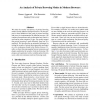Free Online Productivity Tools
i2Speak
i2Symbol
i2OCR
iTex2Img
iWeb2Print
iWeb2Shot
i2Type
iPdf2Split
iPdf2Merge
i2Bopomofo
i2Arabic
i2Style
i2Image
i2PDF
iLatex2Rtf
Sci2ools
USS
2010
2010
An Analysis of Private Browsing Modes in Modern Browsers
We study the security and privacy of private browsing modes recently added to all major browsers. We first propose a clean definition of the goals of private browsing and survey its implementation in different browsers. We conduct a measurement study to determine how often it is used and on what categories of sites. Our results suggest that private browsing is used differently from how it is marketed. We then describe an automated technique for testing the security of private browsing modes and report on a few weaknesses found in the Firefox browser. Finally, we show that many popular browser extensions and plugins undermine the security of private browsing. We propose and experiment with a workable policy that lets users safely run extensions in private browsing mode.
| Added | 15 Feb 2011 |
| Updated | 15 Feb 2011 |
| Type | Journal |
| Year | 2010 |
| Where | USS |
| Authors | Gaurav Aggarwal, Elie Bursztein, Collin Jackson, Dan Boneh |
Comments (0)

